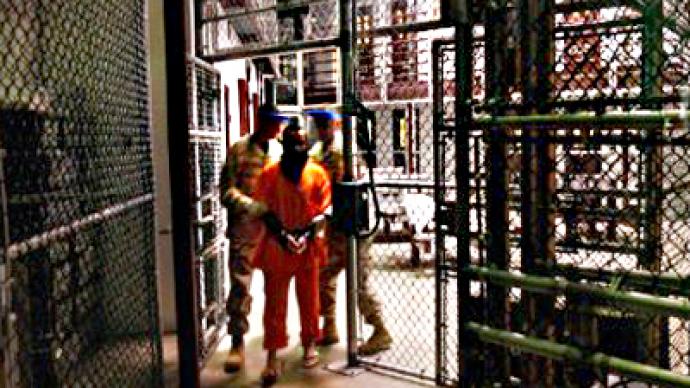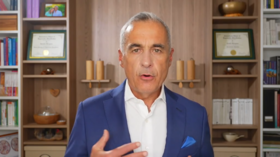Indefinite detention and torture: US already enforcing NDAA

Not even a month after President Barack Obama signed his name to the National Defense Authorization Act for Fiscal Year 2012, the US government is already using the legislation to justify its ongoing detainment of a prisoner at Guantanamo Bay.
Musa'ab al-Madhwani had barely entered adulthood when he first arrived at the military prison at Guantanamo Bay, Cuba in 2002. But in the months between his capture in Pakistan and transfer to Gitmo, the Yemeni national experienced more than most would see in a lifetime. Before he turned 23, he says he was beaten and kicked, threatened with death and suspended by his hands in an underground torture chamber.Now for the prisoner, about to celebrate the 10-year-anniversary of his arrival at Gimo, the rest of that lifetime looks to be spent behind bars thanks to the NDAA. In a statement filed by his attorneys, they describe Musa'ab al-Madhwani as an “easy-going teenager” before he was recruited in a coffee shop by strangers who promised him “a month-long adventure" in 2001. Al-Madhwani agreed, but regretted his decision after being forced into a military training camp in Afghanistan. After al-Qaeda operatives destroyed the Twin Towers, the Afghan facility where he was trained was shut down. He attempted to return to his home in Yemen, but ended up unable to make the trip. In 2002, al-Madhwani found himself living from house-to-house while trying to figure out a way to make it back to Yemen. Eventually authorities closed in a group of insurgents, and al-Madhwani happened to be on the scene. “The group I was arrested with were staying in two apartments,” he would tell an Administrative Review Board. “One person from each apartment refused to surrender and fought the Pakistani forces sent to arrest us. I was in the group that chose to surrender,” he said. According to al-Madhwani, the authorities were “thankful for our cooperation and surrendering without fighting.” That cooperation would only enter al-Madhwani into a decade of darkness.Before ending up at Gitmo, al-Madhwani was brutally tortured in an underground facility in Afghanistan, what he called a “Dark Prison.” He told US officials in 2005 that he believed “It was impossible that I could get out of there alive” and was coerced into announcing his participation with terrorist forces only because he was beaten into submission. The US court system would go later acknowledge this treatment and took al-Madhwani’s word that the confession only came after it was beaten out of him. In January 2010, US District Judge Thomas Hogan called 23 of the 26 documents that government presented as evidence against the man “tainted” because "coercive interrogation techniques" were used to obtain them. Judge Hogan would also rule, however, that the remaining three pieces of evidence were not. Even if months of torture in unimaginable conditions would cause al-Madhwani to admit guilt, the judge ruled that confessions offered up years later, which he viewed as “fundamentally different,” were enough to keep him detained .Judge Hogan would also go on the record to say that al-Madhwani was a “model prisoner” at Guantanamo and explained in court documents, "There is nothing in the record now that he poses any greater threat than those detainees who have already been released." Other excerpts described the prisoner as “a lot less threatening” than former Gitmo detainees already released, and “at best … the lowest level al-Qaeda member” who should be returned to Yemen. The District Court wrote then that the “basis for continuing to hold him is questionable.”Now nearly a decade since arriving at Gitmo, al-Madhwani stands to stay there for a while longer, to say the least. His attorneys filed a petition last year asking that he finally be brought to trial for his alleged crimes. The government did not offer up a response until late this month, only days after President Barack Obama signed his name to the NDAA.The National Defense Authorization Act was met with intense scrutiny from critics when it escaped Congress and opposition even forced the president into offering a signing statement before he inked the legislation addressing the issues. Under the NDAA, the president is granted the authority to indefinitely detain and torture anyone, including American citizens, without bringing them to trial. Although officials say it only affirms detention provisions from earlier legislation, the signing started a slippery slope which could indeed eventually see to it that anyone suspected of a “belligerent act” be put behind bars without a trial. “The fact that I support this bill as a whole does not mean I agree with everything in it. In particular, I have signed this bill despite having serious reservations with certain provisions that regulate the detention, interrogation, and prosecution of suspected terrorists,” Obama said while signing the NDAA on December 31, 2011. Despite these concerns, however, the NDAA was acted into law. Now less than a month later, those provisions that Obama said were of concern are now already being used to keep Musa'ab al-Madhwani further behind bars.Attorneys for al-Madhwani filed a petition last year to ask the court to re-investigate the case and perhaps finally bring the detainee before a jury for his alleged crimes. In their response, the United States Supreme Court writes that the ongoing detention of this “model prisoner” is perfectly by-the-books, as the National Defense Authorization Act allows it. In response to the cert petition filed last year by al-Madhwani’s attorneys, the Supreme Court answers by quoting a provision of the NDAA. “In Section 1021 of the National Defense Authorization Act for Fiscal Year 2012 (NDAA), Pub. L. No. 112-81, 125 Stat. 1561 (2011), Congress ‘affirm[ed]’ that the authority granted by the AUMF includes the authority to detain, ‘under the law of war,’ any ‘person who was part of or substantially supported al-Qaeda, the Taliban, or associated forces that are engaged in hostilities against the United States or its coalition partners.”Further in their response, the Supreme Court quotes the Act again, calling up the authority granted to the president to detain any “person who was part of or substantially supported al-Qaeda, the Taliban, or associated forces that are engaged in hostilities against the United States or its coalition partners.”When he added a signing statement to the NDAA, President Obama acknowledged the harsh realities of the legislation but said he would not enforce it on American citizens. That does not mean, however, that other administrations have to abide by that interpretation. Pulitzer Prize-winning journalist Chris Hedges filed a lawsuit against the president earlier this month challenging the legality of the NDAA. In an explanation of the suit, Hedges wrote, “I have had dinner more times than I can count with people whom this country brands as terrorists,” adding, “But that does not make me one.” Regardless, any affiliation with a group branded as such could lead authorities to leap to such conclusions.Another legislation, yet to be approved, would allow the US government to strike citizenship away without a trial, essentially opening up the NDAA for everyone, with or without Obama’s order. That bill, the Enemy Expatriation Act, would strip nationality from anyone concerned a threat. As seen with al-Madhwani, however, even American authorities don’t consider him a threat. He was barely a child when he accidentally found himself on the wrong side of a war with America and for it he was detained and tortured in at least two different facilities by Pakistanis and Americans alike before arriving at Guantanamo. Now a decade later, the NDAA will see to it that the rest of his life will be spent behind bars in the US military prison.














